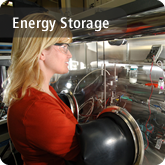
White Light Creation Architectures
The entire spectral range of visible light can be produced by III-V semiconductor LEDs. AlGaInP LEDs can cover the spectral range from red to amber, and their commercial production is relatively mature. AlGaInN LEDs are the prime candidates for producing wavelengths from blue to yellow. Two main approaches for producing white light are being pursued:
Color Mixing
This approach mixes output from three (or possibly four) different colors of LEDs. First, it has the potential for higher luminous efficacy, provided that efficient LEDs of the constituent colors can be developed; there is no Stokes loss from energy down-conversion, as in the blue + phosphor or photon-recycling approaches. Color rendering index will be highest by blending output from at least three different wavelengths. However, substantial problems still exist with this approach. A major limitation is that efficient green and yellow LEDs are still not currently available. A second problem is that LEDs of different colors tend to age and degrade at different rates. Over time, the color balance and color rendering quality of a multi-LED white light may decay significantly; electronic solutions exist, but at a cost. Third, uniform color mixing can be a problem; color variation in the far-field pattern depends on architecture. Fourth, even in the blue, overall efficiencies are far from 100%, and they decrease significantly when driven at high currents.
Wavelength Down-Conversion
By using light from a blue LED to excite fluorescence from a yellow phosphor, the combination of blue and yellow produces white light. Because of the early development of blue LEDs and ready availability of yellow phosphors, the first white LED products, for example flashlights, have used this scheme. The current state-of-the-art uses an InGaN LED emitting at about 460 nm to excite a cerium-doped yttrium aluminum garnet (YAG) phosphor, which is ground into a powder and dispersed in an epoxy cap on the device. There is an unavoidable Stokes energy-loss in converting a blue photon to a lower-energy yellow photon. The color quality in this approach can be enhanced, making it closer to that of incandescent lamps, by adding a red phosphor to improve CRI.
Ultraviolet (UV) LED pumping of RGB phosphors is another possible down-conversion approach. This scheme would potentially be simple to manufacture; it is similar to a television or fluorescent lamp, with electron excitation replaced by a UV LED. Excellent color rendering would be possible, but with fundamental limitations on efficiency because of phosphor conversion efficiency and Stokes loss. In addition, LED packaging material would degrade more quickly from exposure to high-energy near-UV photons.
 ECIS Highlights
ECIS Highlights













 RSS
RSS Google+
Google+ Twitter
Twitter Facebook
Facebook LinkedIn
LinkedIn YouTube
YouTube Flickr
Flickr